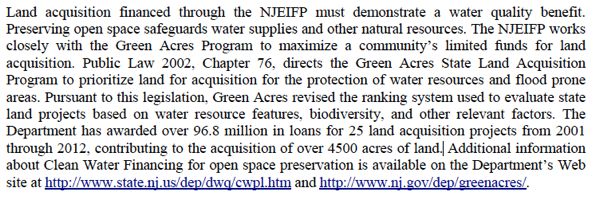Significant environmentally sensitive lands protected by regulation at risk
Time to come down from your Holy Grail
One of the consequences of sprawling development patterns is the loss of important land resources to urbanization. During the 2 decade analysis the Garden State loss substantial amounts of agricultural lands, wetlands and forest lands. Forest loss has been so significant during this time period that by 2007 urban land had surpassed forest land as the most prominent land type covering the state. As of 2007 the Garden State has more acres of subdivisions and shopping centers than it has of upland forests including forests in the Pinelands and all New Jersey’s parks and reserves combined. And the pace of deforestation is increasing. During the early 1986‐1995period of the data (which we label T1) forest loss occurred at 4,300 acres per year. During the middle period of the study (T2 1995‐2002) the rate of deforestation had risen to 5,901 acres per year. The most recent time period of data (T3 2002‐2007) shows that loss jumping to 8,490 acres per year, a 97% increase in deforestation rate from the T1 1986‐1995 period. ~~~ Changing Landscapes In The Garden State, Rutgers/Rowan
The dire findings from the Report above are provided as a reminder and dose of reality.
The reminder is for the conservation groups that formed the Keep It Green Coalition (KIG) to renew the Green Acres program funding. They used to work on land use issues too.
They used to advocate for a host of protective strategies in addition to land acquisition, such as the State Plan, the Highlands and Pinelands regional plans, and various DEP regulatory programs.
That land use planning and DEP regulatory work has largely been abandoned – by their own words – in an obsessive pursuit of a singular “Holy Grail”: (today’s Bergen Record)
“We’ve been searching for this Holy Grail for a long time and now we have it,” said David Epstein, president of the Land Conservancy of New Jersey.
I’ve argued that the selfish obsession is more of a White Whale than Holy Grail, causing all sorts of collateral damage and unethical behavior – starting with stealing funds that were previously Constitutionally dedicated to State Parks and core environmental programs.
But, instead of fighting for new revenues for open space, an approach that has been supported by the voters and funded the Green Acres program for over 50 years, the KIG lacked the stomach for a fight and instead stole existing environmental money.
Consumed with the pursuit of their Holy Grail, conservation groups have remained silent and on the sidelines, as the Christie Administration:
- abandoned the State Plan
- undermined the Highlands Council and Pinelands Commission
- attacked the Highlands and Pinelands regional plans
- rolled back DEP water quality management planning rules, allowing development of 30,000 – 40,000 acres of environmentally sensitive lands;
- rolled back coastal zone management rules, allowing more development in environmentally sensitive and hazardous areas
- proposed rollbacks of stream buffer protections along over 2,000 miles of “ecologically exceptional” waters
- proposed rollback of DEP’s “Septic density standards”, a core protection for the 400,000 acre Highlands Preservation Area
- ignored climate change and dismantled DEP’s existing climate programs
- supported the construction of miles of damaging gas pipelines
- initiated a program of logging Highlands forests
- gutted enforcement and turned DEP into a pro-business “customer service” agency
- abandoned Water Supply planning and ecological constraints on water use
- abandoned the Natural Resource Damage Compensation & Restoration program
- weakened public access rules and failed to aggressively defend the Public Trust Doctrine
- reversed 20 years of watershed planning policy by permitting a new sewage treatment plant on Crosswicks Creek, a low flowing environmentally sensitive Delaware River tributary, to serve a massive new sprawl development on farmland.
The pursuit of the Holy Grail is literally losing ground.
Worse, various frauds have insinuated themselves into the vacuum on land use advocacy, including groups like Sustainable NJ and NJ Future and NJ Citizens Campaign and Together NJ.
These groups reject a traditional advocacy role and do not work on State government planning and regulation in favor of demonstrably ineffective voluntary, local, corporate, consumer, and market based initiatives.
These faux “campaigns” divert resources and channel local activists into politically safe symbolic gestures, while they provide green cover for politicians and corporations and the Christie DEP.
Big corporate oriented Foundations like Dodge and Wm. Penn have shifted their funding away from traditional aggressive advocacy work that focused on government planning and regulation, to funding the pursuit of the Holy Grail and politically safe Green cover projects.
But it wasn’t always like this.
Back in 2002, after 8 years of Whitman Administration “Open For Business” rollbacks, the McGreevey Administration launched several land use and water quality initiatives (they are summarized in this post).
That included amendments to the Green Acres law to prioritize protection of water resources, typically some of the most environmentally sensitive and ecologically valuable lands. According to DEP (page 81):
Compare the 4,500 acres of lands acquired to protect water resources with DEP regulatory protections.
According to DEP, there are 18,126 miles of rivers and streams in NJ.
According to another DEP Report, (map below), 29% (5,256) of these stream miles are designated Category One and have 300 foot buffers. Do the math:
(5,256 miles) X (5,280 ft./mile) X (600 ft buffer/ft)/43,560 ft(2)/acre = 382,254 acres
There are 400,000 acres in the Highlands Preservation Area, almost a million acres in the Pinelands, and thousands more acres of wetlands and transition areas – all protected by regulation and all at risk of losing protections via regulatory rollbacks.
So, the obsession with the Holy Grail needs to end and the KIG groups have got to get back to work on traditional land use advocacy work.
That can start with defending rollbacks to C1 buffers and the DEP Highlands septic density standards.



Pingback: WolfeNotes.com » Bear Canyon, Coronado National Forest – Miller Peak Wilderness